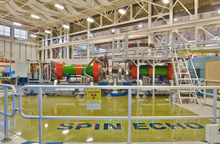CHRNS NSE - Neutron Spin Echo Spectrometer

Located on guide NG-A, NSE is part of the Center for High Resolution Neutron Scattering (CHRNS)supported by the National Science Foundation. Two-thirds of its beam time is reserved for guest researcher experiments through the NCNR proposal system.

| Neutron Spin Echo (NSE) spectrometers use the Larmor precession of the neutrons' magnetic moment in a magnetic field as an internal clock to time the transit of the individual neutrons through two large solenoids, one placed before and one placed after the sample. This method allows one to obtain the highest energy resolution possible (sub μeV) over a wide range of incident wavelengths. NSE instruments directly measure the real part of the intermediate scattering function I(Q,t), i.e. the cosine Fourier transform of the scattering function S(Q,ω), and are used to study slow dynamics found in condensed matter systems. Studies carried out at NIST include polymer dynamics, the collective motion of surfactant membrane in solutions, the motion of liquids in confined spaces, and the spin dynamics in frustrated magnets and spin glasses. |
You are encouraged to contact one of the NSE instrument responsibles before submitting your proposal to discuss the technical details of the experiment.
Specifications/Capabilities
| Guide | NG-A, 50 mm (width) 70 mm (height) |
| λ | from 4.5 Å to 15 Å, Δλ/λ ≈ 20 % |
| Flux at Sample Position | 3.1 × 107 neutrons/cm2/s at 5 Å |
| 2.7 × 107 neutrons/cm2/s at 6 Å | |
| 1.3 × 107 neutrons/cm2/s at 8 Å | |
| 5.0 × 106 neutrons/cm2/s at 11 Å | |
| 1.4 × 106 neutrons/cm2/s at 15 Å | |
| Typical sample size | 3 cm × 3 cm |
| Accessible scattering angle range | from 2.5° to 105° |
| Accessible Q range | from 0.060 Å-1 to ≈1.80 Å-1 at λ = 5 Å |
| from 0.050 Å-1 to ≈1.50 Å-1 at λ = 6 Å | |
| from 0.035 Å-1 to ≈1.10 Å-1 at λ = 8 Å | |
| from 0.025 Å-1 to ≈0.80 Å-1 at λ = 11 Å | |
| from 0.020 Å-1 to ≈0.60 Å-1 at λ = 15 Å | |
| Maximum field integral | 0.44 T·m |
| Dynamic range | from 3 ps to 10 ns at λ = 5 Å |
| from 5 ps to 20 ns at λ = 6 Å | |
| from 10 ps to 45 ns at λ = 8 Å | |
| from 50 ps to 100 ns at λ = 11 Å | |
| from 150 ps to 200 ns at λ = 15 Å | |
| Detector | 32 cm × 32 cm PSD |
Created October 23, 2018, Updated September 17, 2025

